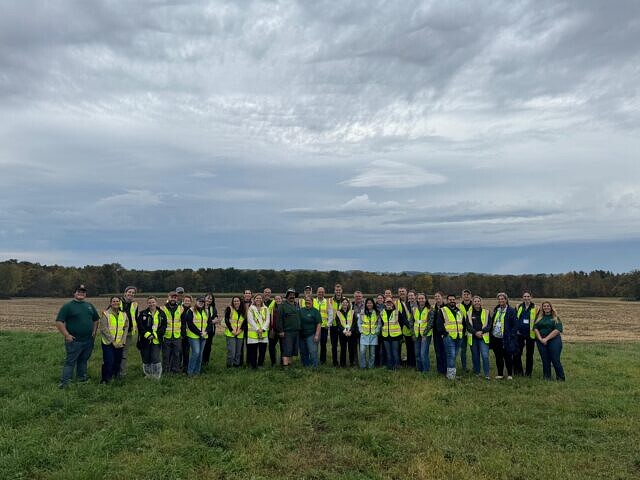Regenerating Together: Transition support guide public release
30th May 2024

Transition support is a fundamental part of SAI Platform’s Regenerating Together programme. The team are proud to publicly release the accompanying Transition Support Guide, which was developed in collaboration with SAI Platform members. The guide builds on the Regenerating Together global framework for regenerative agriculture. It offers comprehensive strategies for implementing regenerative practices, providing practical steps and insights to help the agriculture sector adopt a more regenerative approach at scale.
SAI Platform is well-established in fostering industry alignment, and regenerative agriculture is no exception. Recognising the critical need for a clear definition, an aligned framework, and measurable outcomes, SAI Platform members took collective responsibility to advance regenerative agriculture.
To delve deeper into the importance of transition support we interviewed co-author Robyn Cooper, Crops Manager at SAI Platform, and member contributor Andrew Utterback, Director Global Sustainable Sourcing at Ingredion. They share their insights on why the collective knowledge of SAI Platform’s membership is crucial for providing guidance, generating ongoing insights with wider sector input, and scaling the necessary changes to address today’s urgent challenges across agri-food supply chains.
Why do you see transition support as such a critical part of achieving regenerative agriculture?
Robyn Cooper: We recognise that a clear framework and outcomes are crucial for advancing regenerative agriculture. However, these foundational tools alone are not sufficient to scale the level of change required. The true impact of these tools depends on the capacity of the industry to effectively implement them. This need became evident through the Crops Working Group’s Climate-Smart Agriculture (CSA) learning journey. Our members wanted practical steps for transitioning to regenerative agriculture, leveraging our platform’s position to deliver guidance and insights. This guide aims to fill that need.
What have been some of the key learning points from this process for you?
Andrew Utterback: Executing a regenerative agriculture project is complex and requires agreement across multiple stakeholders and supply chain partners. Internal alignment is crucial, including clear project outcomes, funding, and collaborative partners to manage costs and build value. The project location and focus must align with the crops, geography, value chain, and growers involved. Grower buy-in is essential, and the right partners are needed to ensure interventions at the farm level strike the desired change and benefits for all involved.
Measurement tools to track and report KPIs are also vital. Alignment across the supply chain on both outcomes and process steps is necessary for success. The Regenerating Together programme helps standardise focus areas, practices, and measurement tools, facilitating quicker and more successful transitions.
How have you developed the guide?
Robyn Cooper: From the open sharing of the lessons learned and challenges identified in the Crops Working Group’s CSA learning journey, we developed ‘skeleton modules’ with guiding questions and practical steps. These modules emerged as essential for implementing regenerative agriculture initiatives. Groupe Ageco consultants advised on combining these modules into a practical, easy-to-navigate format. The guide is a ‘work in progress,’ and we invite sector actors to help shape it further by sharing relevant case studies and resources.
Why do you consider it important to share learnings widely?
Andrew Utterback: The broader adoption and execution of regenerative agriculture within SAI Platform’s membership and across the sector is essential to meet commitments efficiently and swiftly. As more growers and supply chain partners observe their customers investing in regenerative practices, the market signal for participation becomes clearer. Momentum can be built by transitioning more land using SAI Platform’s approach, which combines the benefits of global standardisation and context-specific adaptation.
“To meet climate and regenerative agriculture commitments, the food and beverage industry must begin transitioning to regenerative agriculture at a landscape level. Given that farmers rotate crops and sell into various supply chains, maintaining consistent programmes and messaging from SAI Platform members will drive larger-scale change.”
Andrew Utterback, Director Global Sustainable Sourcing, Ingredion.
I firmly believe that landscape-level collaborative projects across crops and supply chains are key to the rapid adoption of regenerative agriculture. Standardisation and transition support, as embodied in the Regenerating Together Programme, are critical. Simply put, we have no other option if we want to achieve these goals as a sector, and we are excited to share these resources more widely.
Why is industry collaboration important to developing transition support?
Robyn Cooper: The transition support guide is part of a larger support ecosystem in development, positioning SAI Platform as a trusted transition support partner for our members. We aim to bring regenerative agriculture to life globally, ensuring iterative learning and improvement of our resources. Our support focuses on building capability through knowledge exchange, access to key resources, and catalysing collaboration across value chains and landscapes. This includes webinars, workshops, case studies, additional guidance, and matchmaking for new initiatives, hosted on our member platform ‘My SAI Platform.’ Partnering with members and others is key to generating new insights and unlocking action.
SAI Platform’s Regenerating Together Transition Support Guide represents a significant step forward in the collaborative effort to implement regenerative agriculture. By leveraging the collective knowledge and experiences of its members, SAI Platform aims to provide practical, actionable guidance to facilitate the transition toward sustainable agricultural practices. The ongoing development and sharing of resources will be crucial in driving sector-wide change and achieving climate and regenerative agriculture commitments.


